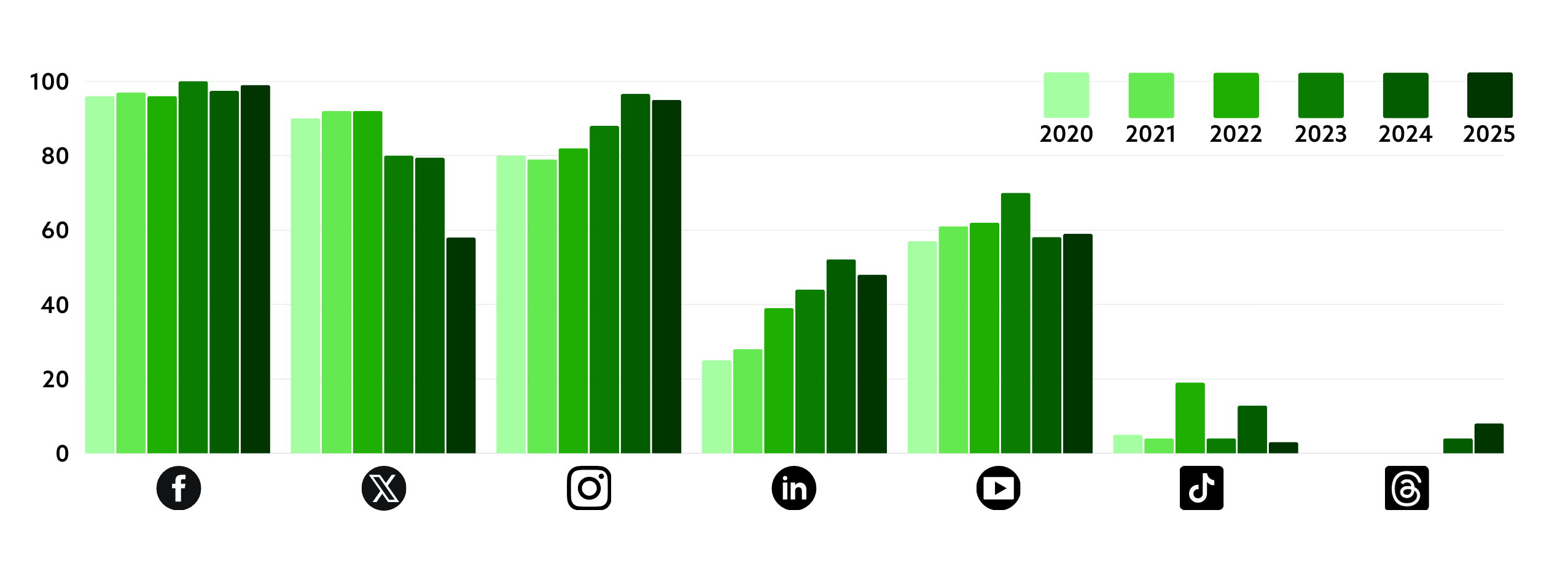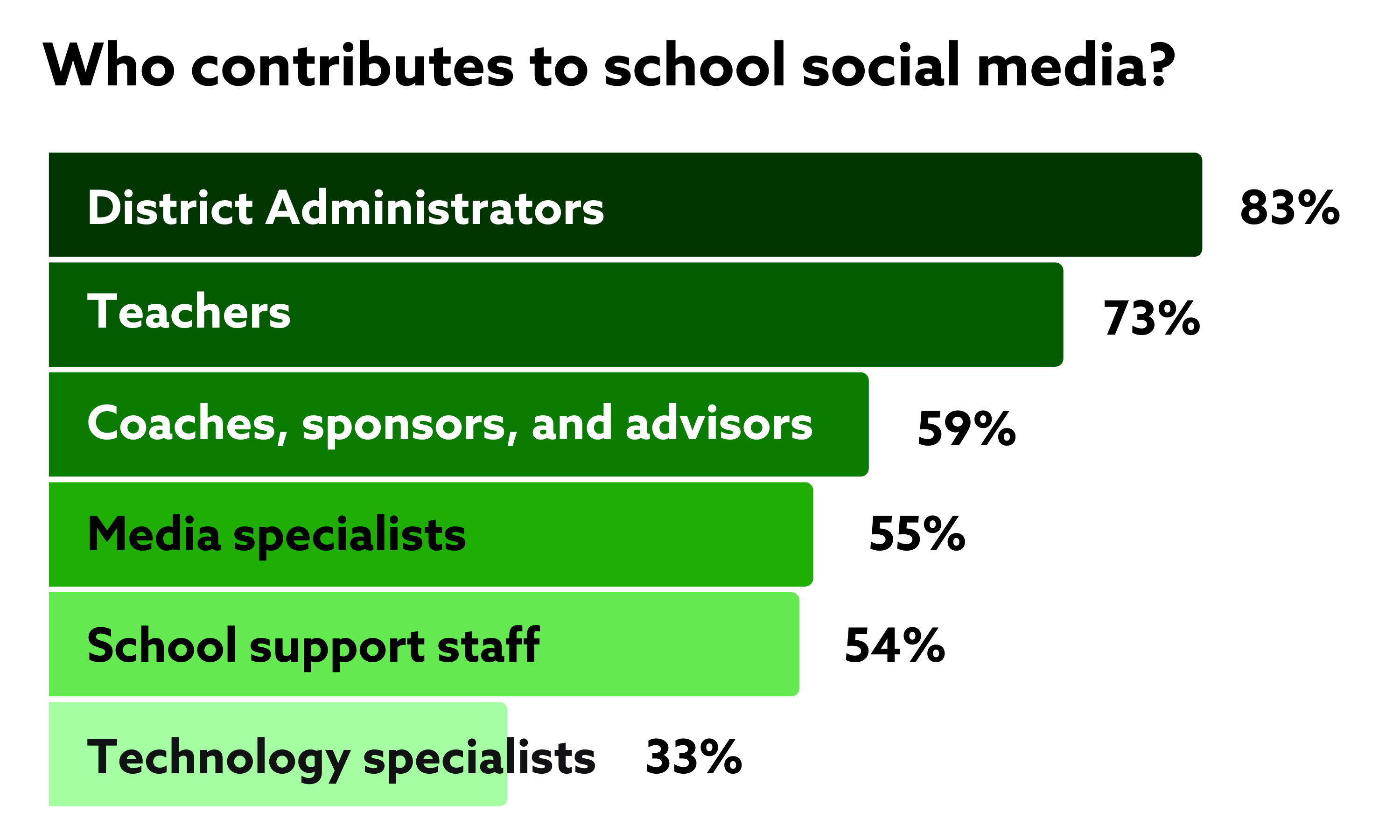Just a few years ago, parents and families played a significant role in their children’s day-to-day school experiences. Many remember walking their child into class on the first day, helping them find their desk, seeing where they’d hang their backpack, and which new friends they’d sit next to.
Fast forward to 2025, and the family experience looks dramatically different. Safety protocols and shifting policies mean families are more often kept at a distance. Parents of younger children rarely step into classrooms, while parents of older students are adjusting to new cell phone restrictions, leaving them with less contact throughout the school day.
In this new reality, schools need a way to bridge the gap—and social media has become that tool. The recently released 2025 Social Media in Education Report shows how schools are adapting to this shift and what it takes to connect meaningfully with their communities in an era when family engagement is increasingly digital.
How Schools Are Using Social Media to Strengthen Communication
In 2025, schools are managing staffing shortages, safety concerns, enrollment pressures, and the constant demand for communication. Communities expect updates in real time, making social media storytelling a daily priority. Where parents once walked into classrooms to see their child’s world firsthand, now they look to Facebook, Instagram, and YouTube to get a glimpse of school life. These platforms have become the digital front doors of schools, where announcements are shared, milestones celebrated, and school culture is brought to life.
The 2025 Social Media in Education Report confirms this. Seventy percent of schools say they now have social media formally integrated into their communications plans. Additionally, nearly every school uses Facebook (99%) and Instagram (95%). This shift shows how schools are adapting to the new realities of parent and community engagement. Being active on these platforms is no longer optional.
Platform Shifts in School Social Media
The platforms schools rely on have shifted dramatically this year. While Facebook and Instagram remain dominant, schools just aren’t committing to other platforms in the same way.
YouTube has surged to become the third most-used platform, now at 59% adoption. That rise has everything to do with video. Schools are leaning into podcasts, video updates from leadership, video announcements, and student-produced pieces to make mundane content more visible and engaging.
Usage of X (formerly Twitter) has plummeted from 92% of schools using it in 2022 to just 58% this year. The drop isn’t only about shifting audiences; it reflects the controversies and uncertainty surrounding the platform itself. For schools, where safety and reliability are paramount, that kind of volatility makes it difficult to justify continued investment.
The story is similar for TikTok. Unsurprisingly, only 3% of schools report using it in 2025. This is down from recent years as 2024 was a rough year for the platform. Policy restrictions, safety concerns, and uncertainty about its future have made TikTok unsustainable for most districts. Still, short-form video remains in demand, continuing to drive engagement across platforms. This means TikTok’s decline may prove to be a temporary blip, with the possibility of a resurgence in 2026 as the dust settles.
LinkedIn, which spiked in 2024, dropped this year to 48% usage. While it isn’t a natural fit for day-to-day storytelling, it remains one of the most effective platforms for staff recruitment and positioning districts as an employer of choice. With schools facing teacher shortages and retention challenges, LinkedIn is arguably where schools should be putting the most investment if they’re looking to add to social media strategy.

What Schools are Posting on Social Media
Just as important as where schools post is what they choose to share and which content delivers real results.
This year, schools reported sharing student and staff highlights (68%) the most, followed closely by classroom highlights (67%). Together, these categories sit nearly 25% higher than the next, general announcements (43%). Following announcements the most common post types include extracurricular event highlights after the fact (30%), announcements of upcoming events (28%), and student life updates (20%).
When it comes to which content is getting the most engagement, the results are similar. Respondents said student and staff highlights, classroom highlights, and extracurricular highlights consistently drive the most reactions, comments, and shares. Alumni stories, celebrations of achievements, and campus highlights also rank high, reinforcing that people-focused storytelling is what grabs audience attention.
This doesn’t mean schools should stop posting announcements or informational content. Instead, it means those posts work best when they’re grounded in the people who bring them to life. For example:
- Instead of sharing a graphic with the spring concert date, feature a student practicing their solo and have them invite the community to watch the performance.
- Rather than posting a generic staff recruitment post on LinkedIn, spotlight a current teacher and why they chose to work and stay in your district.
- Instead of asking for votes in a bond campaign, share a video of a student explaining how the funds will impact their school experience.
It’s not just what schools post, it’s how. Every post, even the need-to-know content, can be an opportunity to show the human side of school life.
Who Contributes to School Social Media
The good news: school social media is no longer a solo gig. Content creation is a collective effort, and that shift is changing what stories schools tell and how they gather them.
This year, district administrators (83%) and school administrators (85%) reported contributing to social media at higher rates than ever. For leaders, showing up on social isn’t just about lending a helping hand, it’s about being visible and approachable. A short video update from a principal or photos of leadership visiting classrooms can prove them to be ingrained in the community.
School staff also plays an important role: 73% of teachers, 59% of coaches and sponsors, 55% of media specialists, and 54% of support staff contribute to school social media. Next to students, staff are closest to daily school life, giving them a unique vantage point for capturing moments that matter: in the classroom, at lunch, on field trips, during after-school activities, the list goes on.

And students are contributing too. In 2025, 25% of schools already have students actively contributing to social media, and another 43% want to. Most contribute through clubs or classroom projects under staff guidance. The benefits are clear: student contributors produce authentic content their peers and families engage with, and they gain valuable skills in writing, design, media, and digital citizenship along the way.
Survey respondents overwhelmingly agree that student involvement is nothing but beneficial. Regret about involving students in content creation remains extremely rare. Schools report that when students take part, the quantity and quality of content improves, engagement soars, and school culture benefits. As one respondent put it, “I have noticed a major shift in student attitudes towards our school. They enjoy being celebrated and celebrating others.”
The takeaway: school social media thrives when many voices are involved. Leaders build trust, staff add depth, and students bring authenticity and fun. Together, they reflect the true experience of a school community.
Challenges and Risks of School Social Media
As school social media grows more sophisticated, it also grows more complex. The report shows that 83% of schools are dealing with rogue accounts. That is, pages run by students, parents, or community members without district oversight. That number is up from 69% last year, a sharp reminder that as schools tell more stories online, they must also protect their brand and community. Rogue accounts can confuse familes, spread misinformation, or even create liability if they appear “official” without actually being managed by the school.
At the same time, schools are still struggling with how to manage the workload behind school storytelling. Few respondents reported using task or project management tools tied directly to their social media management platform. Most schools are still coordinating content through scattered emails, text messages, forms, and shared folders—a system that might work when one person is posting, but quickly breaks when many contributors are involved.
For school communicators, these numbers are both a warning and a guide. They signal the need for:
- Clear account ownership: Every official account should have known managers, and rogue accounts should be reported or folded into official channels where possible.
- Structured workflows: Instead of relying on informal processes, schools need comprehensive moderation systems and scheduling tools.
- Proactive communication: Audiences should know which accounts are official and where they can find the most accurate information.
This is also where the difference between a basic publishing tool and a full-scale social media management platform for schools comes in. Tools like Class Intercom are built with the unique needs of education in mind:
- Allowing schools to set roles and publishing permissions so leaders, staff, and students can contribute without sacrificing brand oversight.
- Including approval workflows so nothing goes live without being reviewed by a moderator.
- Keeping content organized across brands and accounts, making it easier to manage the growing volume of posts and contributors.
- Archiving all posts automatically for compliance and accountability.
- Supporting unlimited contributors so every voice can be included without added cost.
- Centralizing management so school communicators can monitor, flag, and respond to content across channels in one place.
- Enabling task and project management within the platform so schools can plan, assign, and track social content alongside publishing.

The benefit is twofold: schools stay safe and compliant, but they also gain the confidence to empower more voices. Instead of limiting contributors to avoid chaos, schools with the right systems in place can invite leadership, staff, and students to share authentic stories while maintaining consistency and security. Because the more voices involved in storytelling, the greater the need for structure.
Looking Ahead
The 2025 Social Media in Education Report shows how far schools have come, but also where they’re headed with social media. It’s now integrated, expected, and one of the primary ways schools connect with their communities. The next phase isn’t about adoption, it’s about advancement.
In practical terms, that means moving from simply “being present” on social media to building strategies that are sustainable and scalable. The schools that will thrive are those that:
- Double down on platforms and content types that truly engage families and students.
- Empower more voices while maintaining clear oversight.
- Build workflows that allow teams to adapt quickly as platforms and audiences change.
At Class Intercom, we believe school social media works best when it reflects the real voices of a school community. Our platform equips schools with the workflows, permissions, and moderation tools needed to involve more contributors safely, keep accounts secure, and adapt as platforms evolve. The result? Social media that not only informs, but truly connects—building trust, celebrating people, and strengthening communities. Follow the link below to get in touch.
